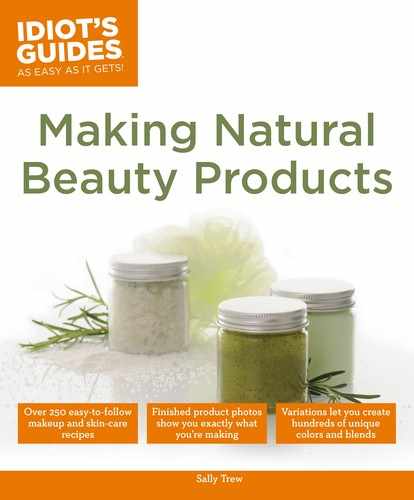
the product would work best in—lotion, cream, salve,
balm, etc. Next, I turn my attention to the properties
of the oils and butters I’m thinking of using. Many oils
and butters have common properties and would bring a
repeat of the same values to your formulation. You want
to avoid that repeat as much as possible—it’s a waste of
good oils.
For example, look at sweet almond oil and grapeseed
oil, two easily accessible and inexpensive oils. Sweet
almond oil contains essential fatty acids and vitamins
A, B
1
, B
2
, B
6
, and E. It also contains mono- and
polyunsaturated fatty acids. Grapeseed oil contains
procyanidolic oligomers, which are antioxidants that
also inhabit allergic reactions. Plus, grapeseed oil has
slight astringent properties. Both of these oils bring
totally different properties to a formulation.
I love to formulate. Give me a challenge, and I will
happily meet it. Tell me there’s no way to make a
product without chemical ingredients, and I won’t give
up until I’ve gured out how to make it with natural
ingredients. For this book, that challenge was natural,
chemical-free mascara. I have to admit, I almost threw
in the towel, but just when I was ready to give up, my
formulation worked!
Some of you might be wondering how you can
formulate your own products. That’s what this appendix
is all about.
When I decide to formulate a new product, I rst sit
down with pen and paper. I decide which skin type or
age group the product is going to be for and if it will be
helpful to certain skin issues. I then decide what form
how to formulate your
own products
C
Ch16_NB_Formulating.indd 242 5/23/13 4:18 PM

Now let’s look at avocado oil. It contains vitamins A,
B
1
, B
2
, D, E; pantothenic acid; protein; lecithin fatty
acids; and sterolins. These sterolins are known to
help fade age spots, heal sun-damaged skin, and help
diminish the appearance of scars. Avocado oil is not
only good for the skin but also good for the hair, thanks
to two important B vitamins that help strengthen the
hair strands just like sweet almond oil.
Now look at the differences in these three oils. Sweet
almond oil and avocado oil have many of the same
properties, but each brings something different. It’s
those differences that will help you decide which one,
if either, you want to use in your formulation.
After that, think about what additives will help certain
issues, like wrinkles, acne, or any other skin issues.
You only want to use a few additives, if you use any.
They’re usually expensive, too. If you do want to
include additives in your formulation, you don’t need
two or three separate additives that work for wrinkles.
Instead, use one additive for wrinkles, one that tightens
the skin, and one that helps repair skin.
A well-known chef once told me you don’t need 10 or
so spices and ingredients to make a wonderful dish.
You just need a few of the right ones. Less is more; so
remember this and keep your list of ingredients down
to a manageable amount. And be sure to keep them as
natural as possible, too!
Never use any of the following essential oils on preg-
nant women or small children:
Camphor Nutmeg
Cedar wood (both types) Parsley seeds
Citronella Pennyroyal
Dalmatian Sage (both types)
Fennel Valerian
Hyssop Wintergreen
Myrrh Yarrow
These essential oils are safe for use on cats and dogs:
Cedar wood (Atlas) Myrrh
Chamomile Rose
Eucalyptus Rosemary
Ginger Rosewood
Lavender Valerian
Never give these internally, and don’t use more than
.6 percent total for the total weight of the product. So
for 8 ounces (226.8 grams), you’d only use .05 ounce (1.4
grams). Be very careful, and watch to be sure your pet
doesn’t have any reaction to the essential oil or essen-
tial oil blend. If he or she does show a reaction, consult
your veterinarian.
Ch16_NB_Formulating.indd 243 5/23/13 4:18 PM
..................Content has been hidden....................
You can't read the all page of ebook, please click here login for view all page.
